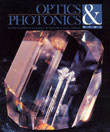
October 1990 Issue
- The Future of Manufacturing with Optical Microlithography
- Switching, logic, and storage Optics vs. the Competition
- Optical interconnections in digital systems—Status and prospects
- Voluntary standards work yields dividends
- Fax boards speed up the faxing process
- The edible hologram
- Crystal growth in China
- Browse all Issues
Feature Articles
The Future of Manufacturing with Optical Microlithography
Optical microlithography has been used for over 30 years as the preferred method of image formation in the manufacture of silicon devices and other semiconductor components. Its demise as the premier imaging technology, was predicted at about 1 μm feature sizes by proponents of alternative imaging technologies and others who underestimated the ability of optical tool manufacturers to improve optical and mechanical system performance to the degree necessary to support the production of increasingly complex devices with ever smaller features.
by Colin W.T. KnightSwitching, logic, and storage Optics vs. the Competition
Examining the case to be made for optical data storage, Masud Mansuripur divided the field into three areas: read-only memories (ROM), currently used in compact disk and CDROM technologies; archival storage, the so-called write-once, read- many (WORM) applications; and erasable drives and media, which use either the magneto-optic or phase change mechanism. All products in the erasable category available today make use of magneto-optics, Mansuripur claimed.
by Dennis G. HallOptical interconnections in digital systems—Status and prospects
In computing, trends toward parallel processing, multiprocessor computers, higher operating speeds, and larger as well as denser very large scale integrated (VLSI) circuits have provided an impetus for the development of advanced interconnection technology. Multiprocessor computer designs tend to require both a larger number and a higher density of interconnections with a higher degree of connectivity than single-processor computers. The combination of higher operating speed, longer distances, and higher density leads to problems in maintaining signal integrity because of parasitic reactances, impedance mismatches, crosstalk, dispersion, and frequency-dependent skin effect losses. Also, as chip designs become larger and denser, the so-called pinout problem, in which the number of input/output pins and pads is limited by the density of wirebonds, is of increasing concern to VLSI circuit designers.
by D. Z. TsangVoluntary standards work yields dividends
As the following anecdotes illustrate, volunteering to work on optical standards could be in your company's own best interests. At a recent conference on high speed photography, someone noted that there once had been seven manufacturers of photographic camera systems for tracking missiles, etc. on various U.S. military ranges. The cameras on these systems have been changed to electronic imaging systems, but each manufacturer adopted a different camera. When the various ranges wanted to compare data, they could no longer trade photographs, but rather had to send magnetic tapes, each having different methods of encoding the data.
by Robert E. ParksFax boards speed up the faxing process
In previous columns, we discussed two ways to communicate with colleagues: electronic mail and bulletin boards. These methods are Useful, particularly for transferring large files and for transferring data or text that will be edited, manipulated, or otherwise used in machine-readable form. However, there are several features of electronic mail that can cause problems: 1) the sender often must specify the route the mail must take to the recipient and this route can depend on the machine of origin; 2) the mail is not always delivered immediately since intermediate machines in the delivery path may hold the message while awaiting empty lines, a low workload, or a scheduled delivery time; 3) mail that crosses network boundaries can get lost or mangled, so the recipient generally must confirm the arrival of important files; 4) since there is no universal format for storage of graphic information, the sender and recipient must discuss the format before pictorial information is transmitted.
by Bob JopsonThe edible hologram
There is a popular misconception that the mass produced holograms affixed to credit cards and Fruit Loops cereal boxes are reflection holograms. Despite the fact that the viewer and light source are on the same side of the hologram, a basic distinction in the classification of holographic gratings is missed.
by Susan M. ReissCrystal growth in China
Crystal growth in China has a long history, going back more than one thousand years. A book written by Cheng Daichang in the Song Dynasty explains that: "Salt becomes brine, exposing under the hot sun; square seals formed, white and lovely; first small then larger; some tens of seals train together." This is exactly the method of growing salt crystals from supersaturated solution by evaporation process. In fact, this kind of crystal growth method had appeared much earlier than it was recorded. The Chinese character of brine means salts in early time, and its pictograph symbolizes a birdseye view of brine evaporating: The square seals of salt crystals crystallized from regularly arranged salt pan.
by M.H. Jiang

![A multiplexed image of a human tonsil acquired. [NIAID] using the iterative bleaching extends multiplexity (IBEX) method.](https://opnmedia.blob.core.windows.net/$web/opn/media/images/articles/2024/0424/departments/202404-cover-web.jpg?ext=.jpg)
